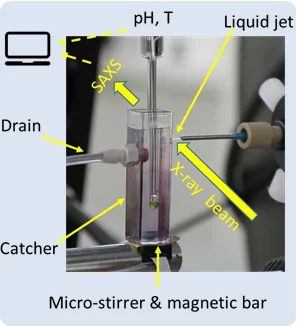
Understanding the early stage in the precipitation pathway is of fundamental relevance in order to achieve an appropriate control at the macroscopic level on the solid formation, for instance in terms of morphology, physicochemical properties, and crystalline phase. CaCO3 is a model system, archetype of several sparsely soluble inorganic materials. The precipitation pathway includes the nucleation and growth of a solid phase from supersaturated solutions. At the early stage, even the physical nature of the entities with a density higher than that of the solvent is a matter of debate.
Indeed, the existence of subcritical embryos is expected even following the classical nucleation theory reasoning with a statistical distribution of sizes, which is influenced by the saturation level. Using advanced analytical tools, such as cryoTEM or analytical ultracentrifugation (AUC), small entities were identified. Nevertheless, sample manipulation is necessary and considering that such entities are in equilibrium with the liquid in which they are formed, any small physicochemical modification can strongly influence their stability. As a consequence, the investigations of these labile entities need to be done in situ, without modifying the equilibrium conditions that lead to their formation. The needed information is not merely the existence of subcritical entities, since this is considered a matter of fact, but their size distribution and nature (e.g., density) before the critical point, which can reflect the existence of a preferential size or a statistical distribution of size or even a different scenario.
Synchrotron‐based scattering techniques play an important role in extracting information from entities suspended in the liquid phase. They are very powerful techniques thanks to the high brightness and flux and modern photon counting detectors. X‐ray scattering is sensitive to the spatial variations of the sample electron density. In particular, SAXS is sensitive to density variations on the scale of nanometers to micrometers, providing very strong, meaningful, and informative scattering information at small angle, yielding information on particles size and their size distribution. At wide‐angle X‐ray scattering (WAXS), the scattering yields information on a subnanometric scale, such as the atomic structure, more detailed information on crystallinity and defects, and elaborate size and shape distribution information. A limiting factor of WAXS is that,typically,the diffraction signal is weaker by several orders of magnitude when compared to SAXS, the latter remaining as the only method exploitable when the sample is characterized by a combination of weak contrast and tiny concentrations, as is the case for near‐saturation CaCO3 solutions. The scattering process follows the reciprocity law: scattering information from larger features corresponds to lower angles. Therefore, the hardware used for such measurements needs to be carefully designed in order to define the optimal trade‐off among energy and flux of the beam, geometry, and detector resolution.
To face this experimental challenge, a pulsation‐free micrometer‐sized reactive horizontal liquid jet setup was built. The liquid jet is not confined by a solid, making it a contactless setup not susceptible to the wall effects. Additionally, the liquid interrogated by the beam is continuously refreshed so the beam damage is intrinsically excluded and the dynamic mixing conditions allow a time‐independent setting of concentrations of chemicals, temperature, pH, saturation, and ionic strength.
Contact:
Dr. Testino Andrea
Senior Scientist
Paul Scherrer Institute PSI
5232 Villigen PSI, Switzerland
Telephone: 0041 56 3105449
E-mail: andrea.testino@psi.ch
Original Publication:
Title: In Situ Liquid SAXS Studies on the Early Stage of Calcium Carbonate Formation
Authors: Ahmed SA Mohammed, Agnese Carino, Andrea Testino, Mohammad Reza Andalibi, Antonio Cervellino
DOI: https://doi.org/10.1002/ppsc.201800482

